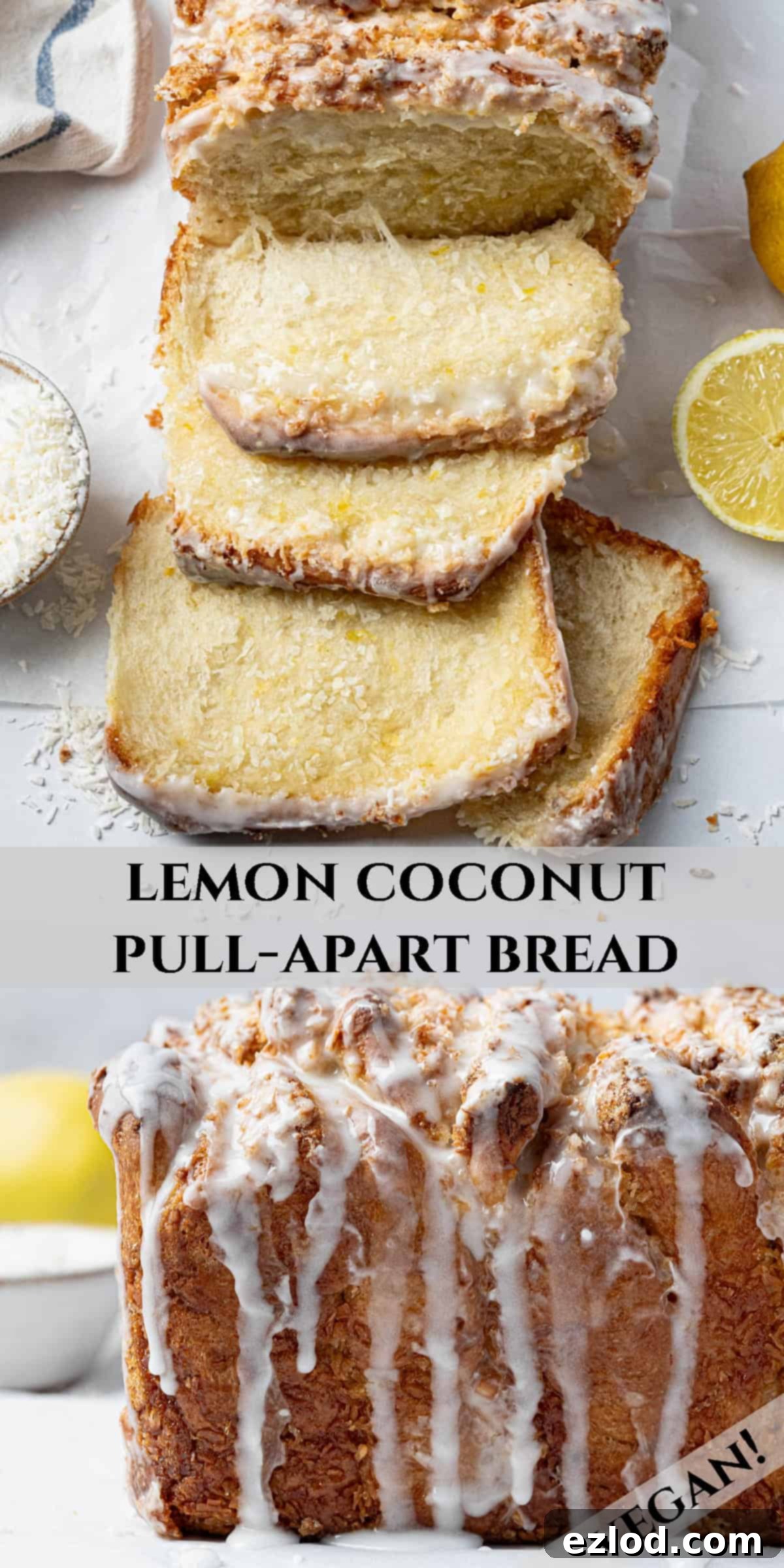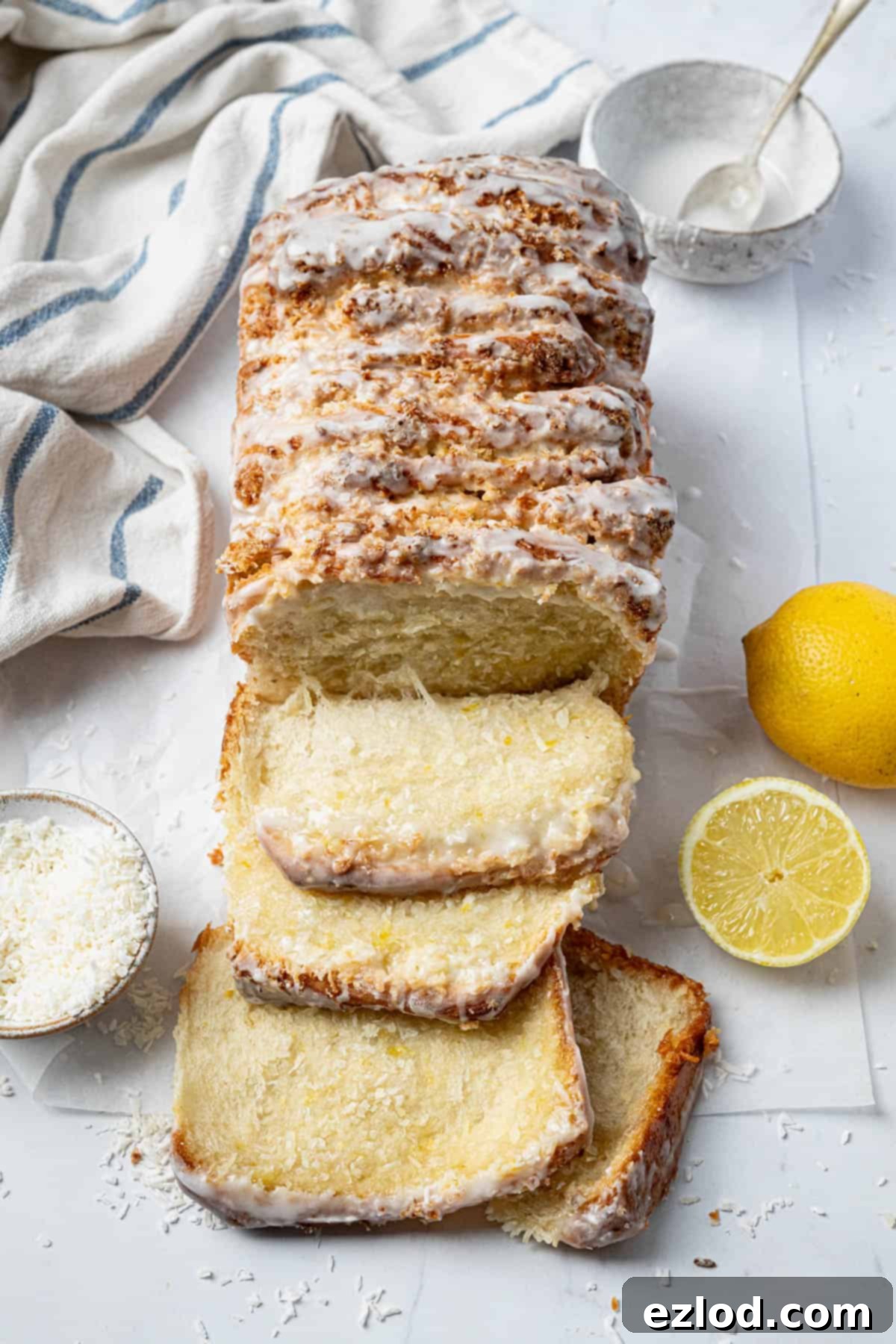Irresistible Vegan Lemon Coconut Pull-Apart Bread: Your Ultimate Share-and-Tear Loaf
Prepare to be enchanted by this vegan lemon coconut pull-apart bread – a true masterpiece designed for sharing, though you might find it hard to resist keeping it all to yourself! This delightful loaf is the epitome of comfort and indulgence: wonderfully soft, exquisitely sweet, and delightfully sticky, all infused with a bright, fresh, and irresistibly summery blend of lemon and coconut flavors. It’s the perfect centerpiece for any gathering, promising an experience that is as fun to eat as it is delicious.
Imagine serving this golden-brown beauty warm from the oven for breakfast, brunch, or even as a unique dessert. There’s absolutely no need for knives or neat slices; simply place it on the table and let everyone joyfully tear off individual pieces. Each segment promises a burst of flavor and a satisfying texture, making it an interactive and memorable treat for all.
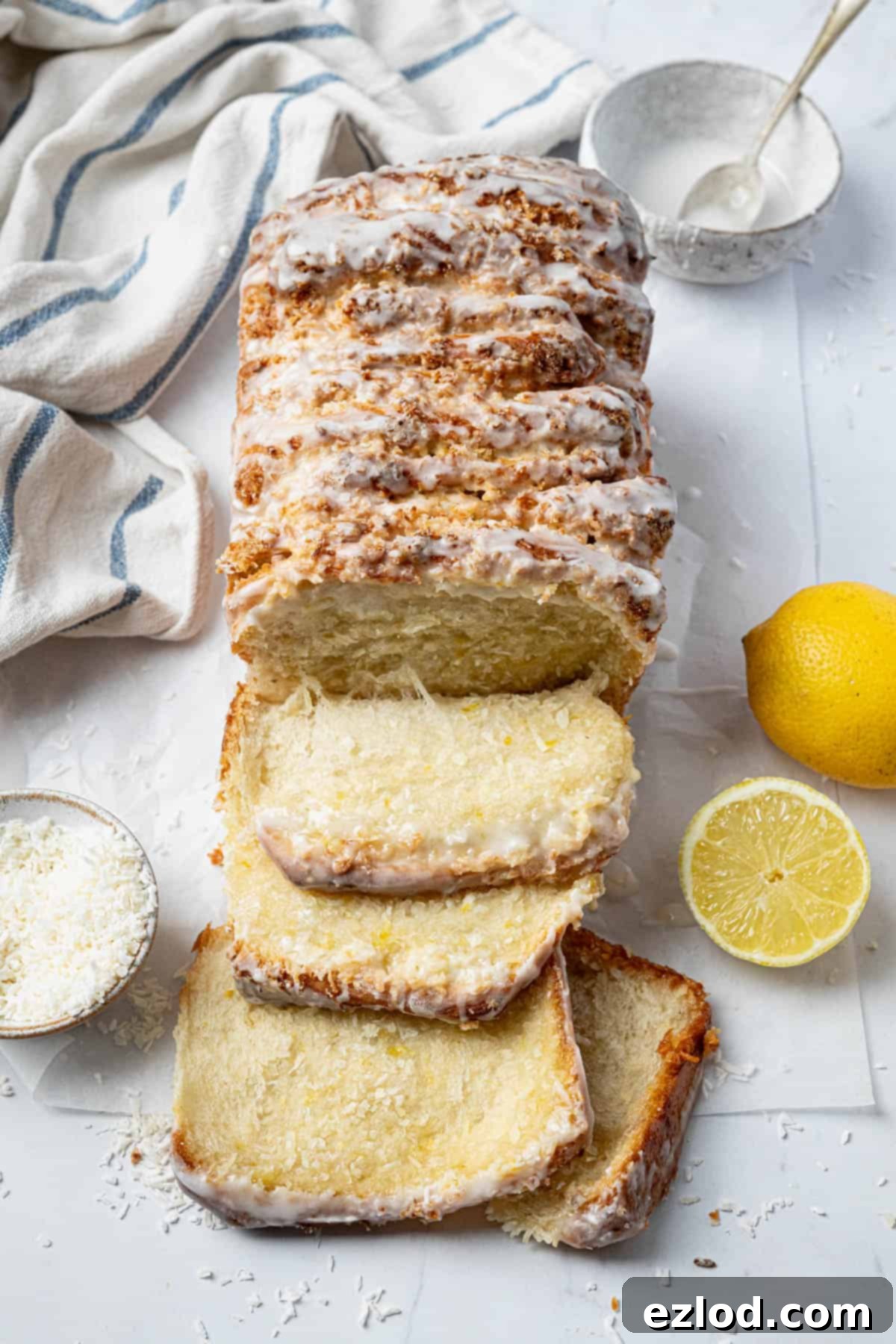
This particular lemon coconut pull-apart bread isn’t just another recipe; it’s a carefully crafted, updated, and entirely veganized rendition of one of my most cherished old recipes. The transformation has elevated it to a real showstopper, delivering an explosion of flavor and texture that will impress even the most discerning palates. It embodies everything you could wish for in a homemade sweet bread.
At the heart of this incredible bread is a dough enriched with full-fat coconut milk, which plays a crucial role in achieving its wonderfully soft and tender crumb. This addition also imparts a subtle, delicate coconut flavor that perfectly complements the vibrant citrus. The luxurious filling is a harmonious blend of creamy vegan butter, granulated sugar, aromatic grated lemon zest, and unsweetened desiccated coconut. To crown this masterpiece, I’ve added a zingy, bright glaze made from smooth icing sugar, freshly squeezed lemon juice, and a touch more coconut milk, tying all the flavors together beautifully.
As this delightful bread bakes, a magical transformation occurs. The butter and sugar in the filling melt and caramelize, creating wonderfully crunchy and golden edges, while the center remains incredibly soft and tender. The design allows it to pull apart effortlessly into individual, sticky, and delicious pieces, making it ideal for sharing. Be warned, though: once you start pulling off a piece, it’s incredibly difficult to stop! And the aroma that fills your home while it’s cooking? Absolutely fantastic. It’s a heavenly symphony of fragrant lemon, freshly baked bread, and warm, nutty coconut – a truly irresistible invitation to indulge.
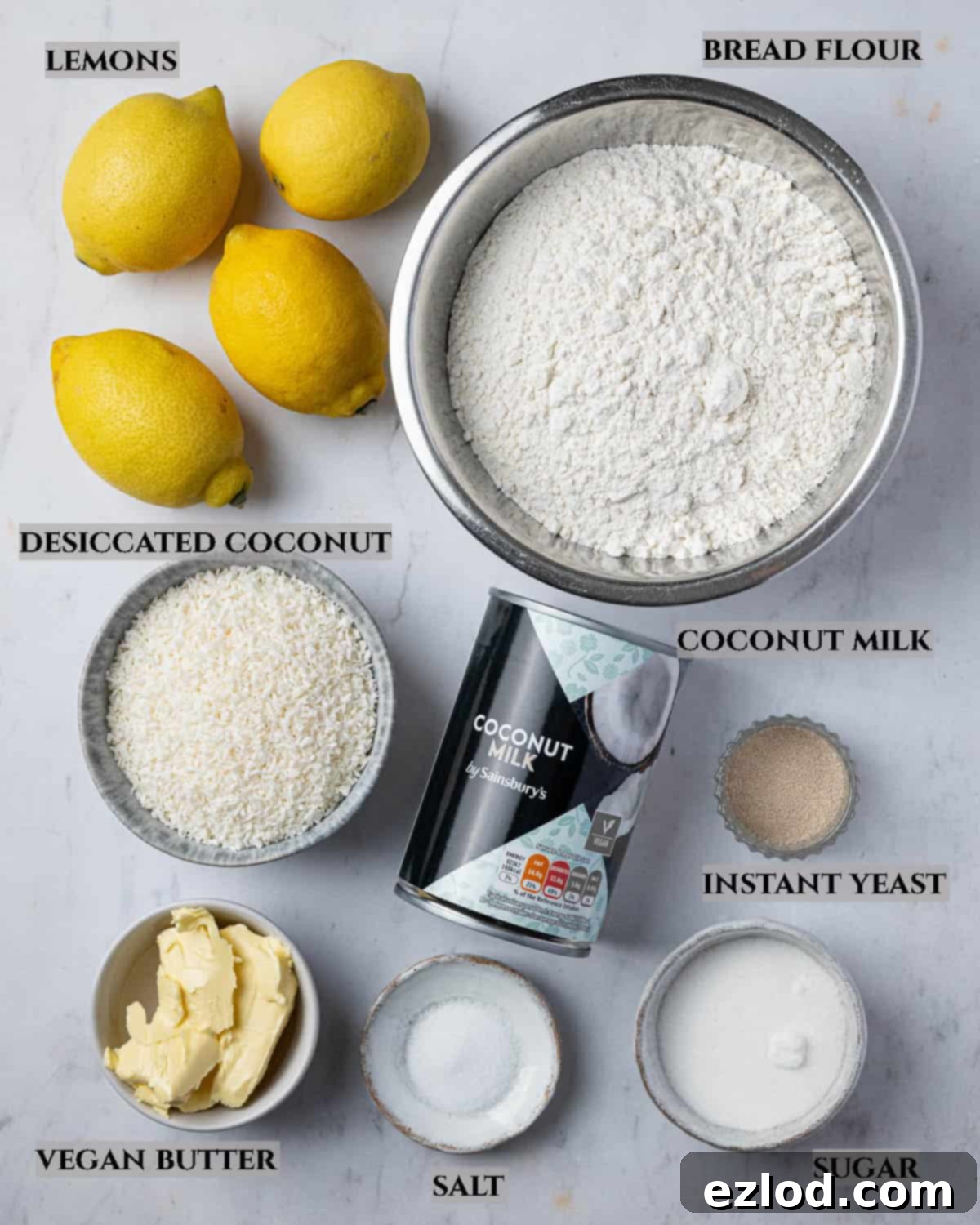
Key Ingredient Details for Perfect Vegan Lemon Coconut Pull-Apart Bread
Achieving the perfect texture and flavor for this lemon coconut pull-apart bread relies on selecting the right ingredients. Here’s a closer look at what you’ll need and why:
Coconut: For the dough, full-fat tinned coconut milk is absolutely essential. Its richness contributes significantly to the bread’s soft, luxurious texture and imparts that delicate coconut undertone. While light coconut milk can be used in a pinch, it will result in a slightly less rich dough. Please avoid using coconut drinking milk, as its thinner consistency will not yield the desired results. For the irresistible filling, you’ll need unsweetened desiccated coconut. Sweetened varieties should be avoided, as the combined sugar from the dough and filling would make the final loaf overly sweet.
Lemons: The star of the show for that bright, fresh, and summery flavor is finely grated lemon zest. You will need zest from approximately four lemons for both the dough and the filling. Always ensure that your lemons are unwaxed, or thoroughly scrub waxed lemons to remove any coating, as you’ll be using the zest directly in your delicious bread.
Bread Flour: White bread flour is my top recommendation for this recipe. Its higher protein content allows for excellent gluten development, which is crucial for giving this pull-apart bread its characteristic soft, fluffy, and slightly chewy texture. While plain (all-purpose) flour can be used, expect a slightly less impressive texture. I strongly advise against using wholemeal flour, as it will make the bread significantly denser and heavier, altering the desired light and airy consistency.
Instant/Fast Action Yeast: My preferred yeast for bread making is instant or fast-action yeast. This type of yeast is incredibly convenient because it can be added directly to the dry ingredients without needing to be activated in liquid first. This streamlines the baking process and ensures a reliable rise. Always double-check the expiry date of your yeast; old or inactive yeast is a common culprit for bread that fails to rise properly.
Salt: Never underestimate the power of salt in bread baking. Beyond simply enhancing flavor, salt plays a vital role in controlling yeast activity and strengthening the gluten structure of the dough. Omitting salt will result in bland bread with a less desirable texture and an uncontrolled rise.
Vegan Butter: When it comes to vegan butter, I generally recommend block butter for most baking applications due to its higher fat content and firmer texture. However, for this specific pull-apart bread, a tub variety of vegan butter (like Flora Original, as used in testing) is perfectly acceptable for both the dough and the filling, as long as it’s not a low-fat spread. Ensure the butter for the dough is softened, and for the filling, it should be very soft, almost spreadable, to ensure even distribution.
Sugar: Either caster sugar or granulated sugar will work beautifully in this recipe to provide the necessary sweetness and contribute to the caramelization during baking. I do not recommend swapping this for liquid sweeteners or alternative granular sugars, as they can alter the dough’s hydration and texture significantly. Additionally, you will need icing (powdered) sugar to create the smooth, pourable glaze that finishes this delightful loaf.

How To Craft Your Own Lemon Coconut Pull-Apart Bread
(For precise measurements and detailed instructions, please refer to the comprehensive recipe card located at the very bottom of this page.)
Step 1: Initiate the Dough Creation. In a generously sized mixing bowl, combine the bread flour, sugar, instant yeast, salt, and finely grated lemon zest. Give these dry ingredients a quick stir to distribute them evenly. Next, pour in the full-fat coconut milk. Begin to mix with a sturdy spoon or spatula, bringing the ingredients together to form a shaggy, rough dough. If necessary, add a tiny splash of water, one teaspoon at a time, until all the flour is fully incorporated and a cohesive mass forms. The dough will look a bit unruly at this stage.
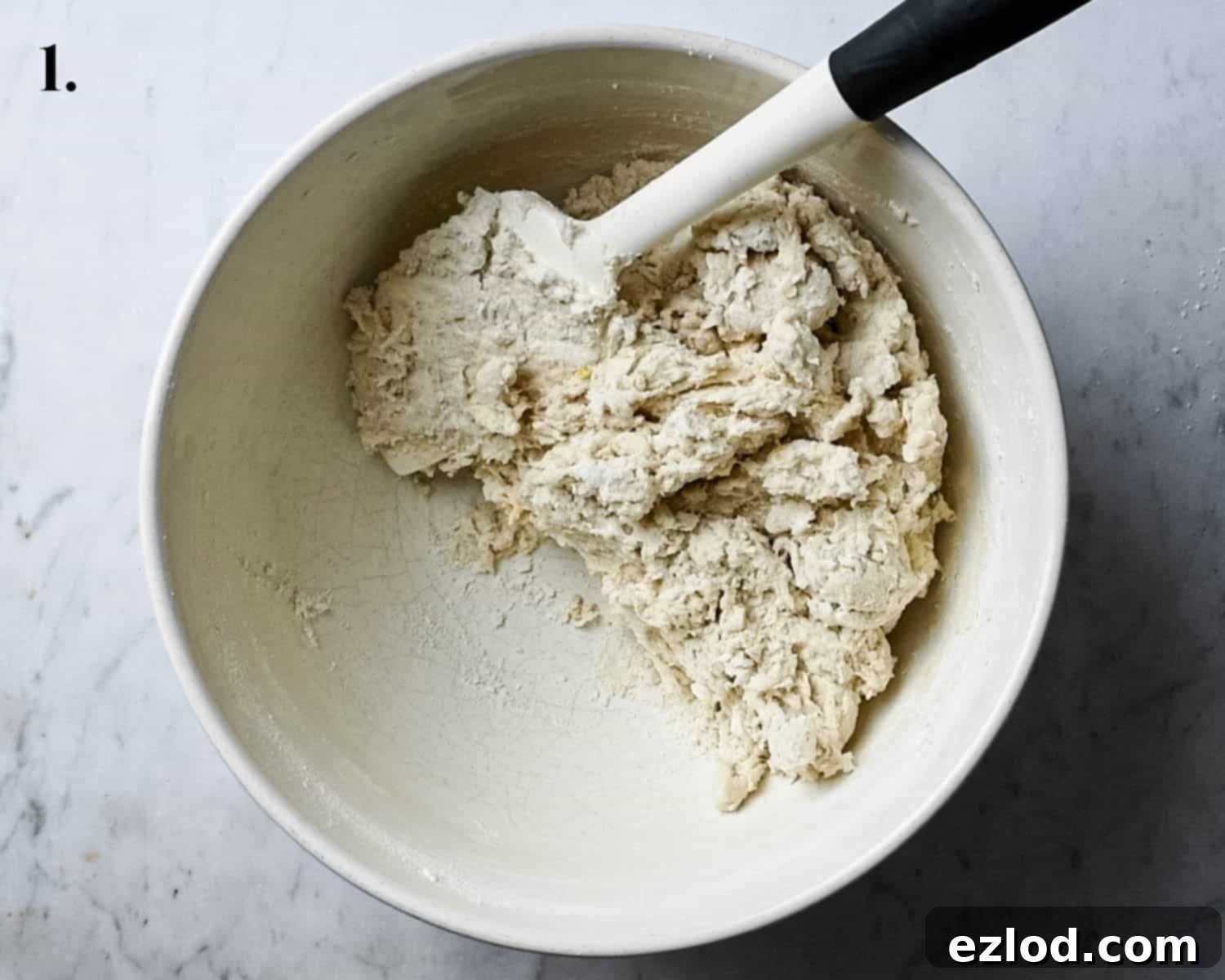
Step 2: Develop the Gluten. Turn the rough dough out onto an unfloured work surface. Knead the dough vigorously for approximately 10 minutes. During this time, the dough will transform from sticky and shapeless into a wonderfully smooth, elastic, and pliable ball. This process is crucial for developing the gluten structure, which gives the bread its signature chewiness and soft crumb.
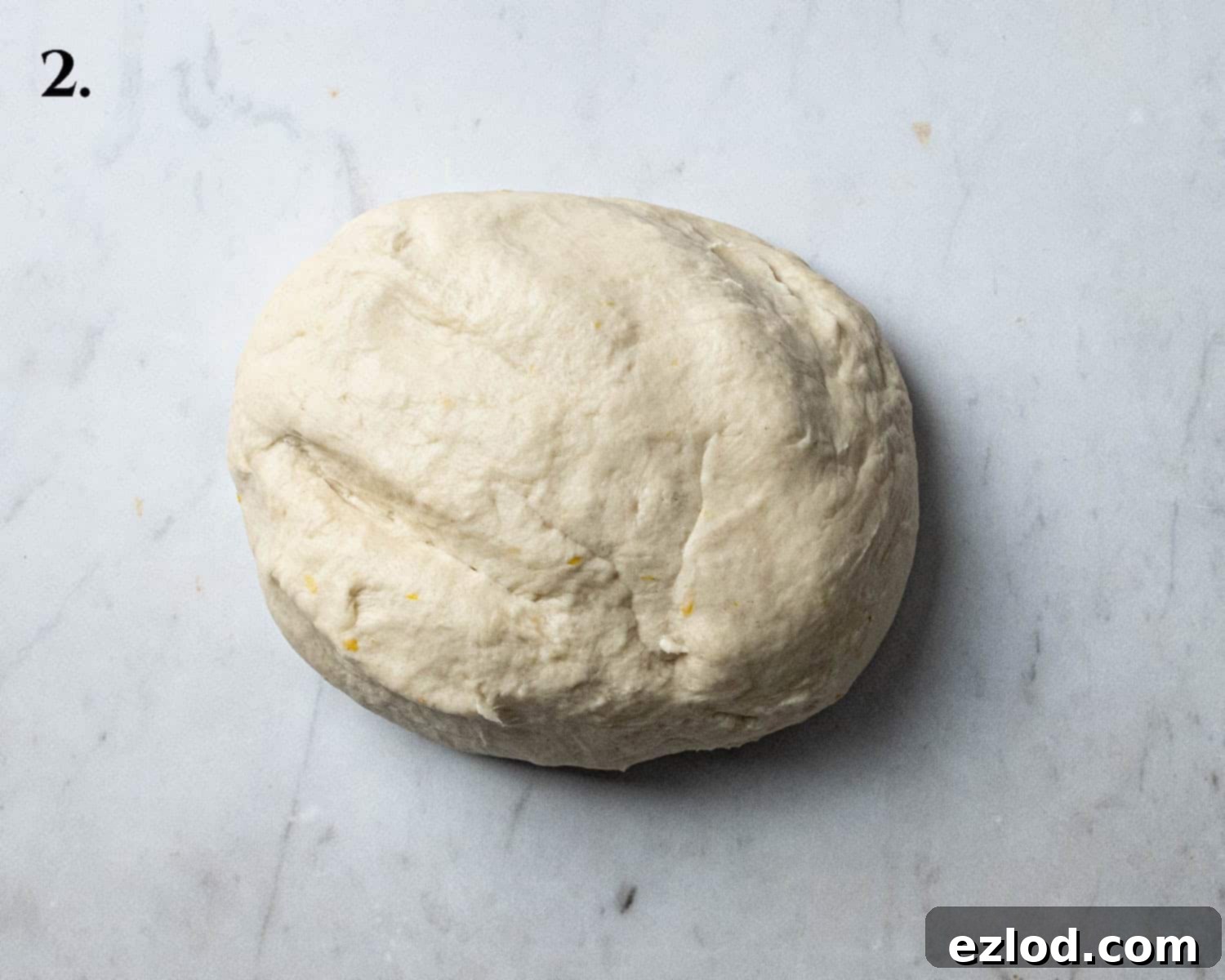
Step 3: Enrich with Vegan Butter. Now, it’s time to incorporate the softened vegan butter into your beautifully kneaded dough. This step might get a little messy at first; the dough will seem to resist the butter and may become very slippery and sticky. Keep kneading, folding, and stretching the dough. With persistent effort, usually after another 5-7 minutes, the butter will be fully absorbed, and the dough will once again become smooth, elastic, and noticeably enriched. Resist the urge to add more flour during this stage, even if it feels quite soft and sticky.
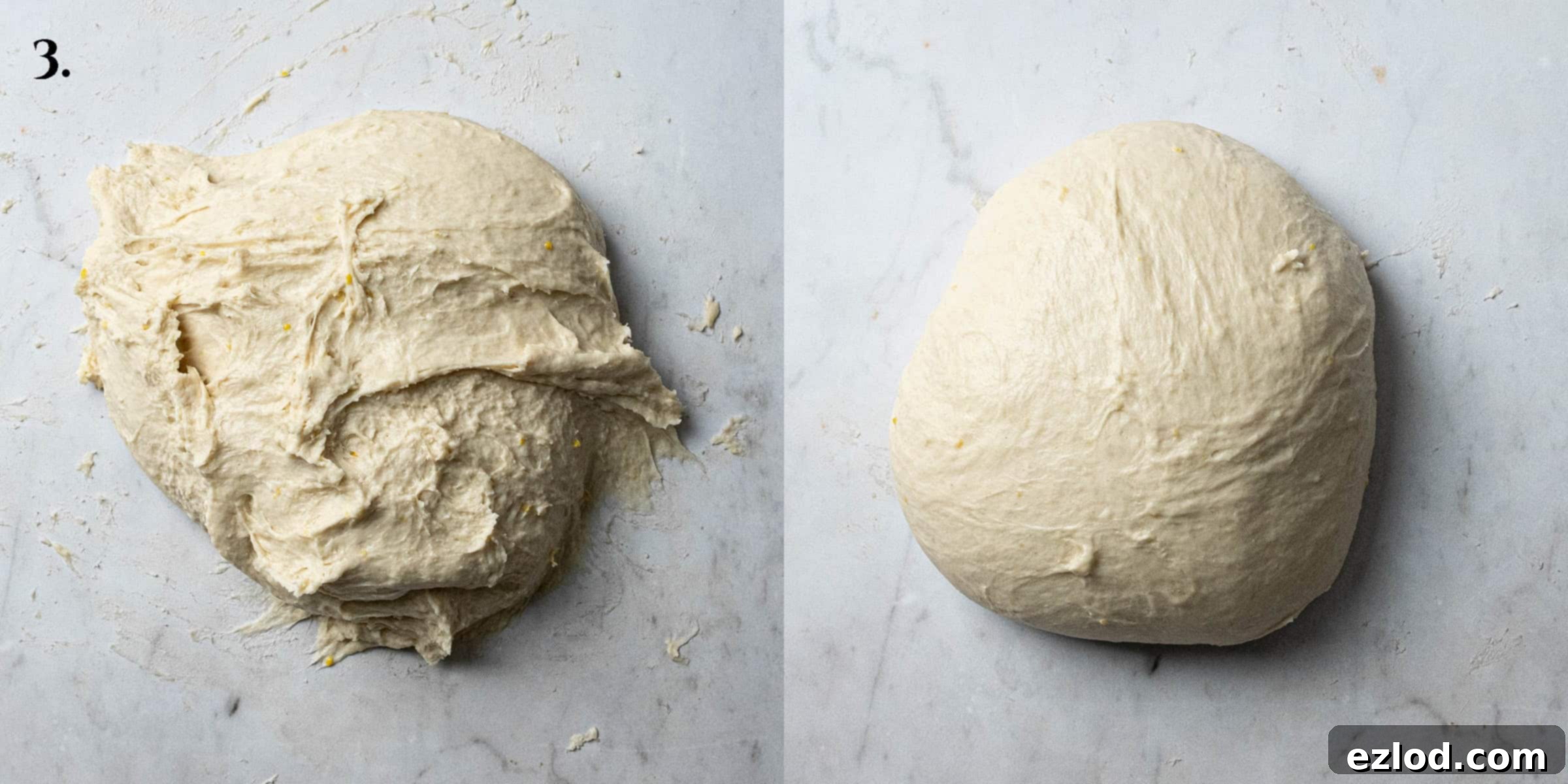
Step 4: First Rise. Lightly grease a clean bowl with a little oil. Transfer the kneaded dough into this bowl, turning it once to coat lightly. Cover the bowl tightly with plastic wrap or a damp kitchen towel to prevent it from drying out. Place the covered bowl in a warm, draft-free spot and allow the dough to rise until it has visibly doubled in size. This typically takes about an hour to an hour and a half, depending on the ambient temperature.
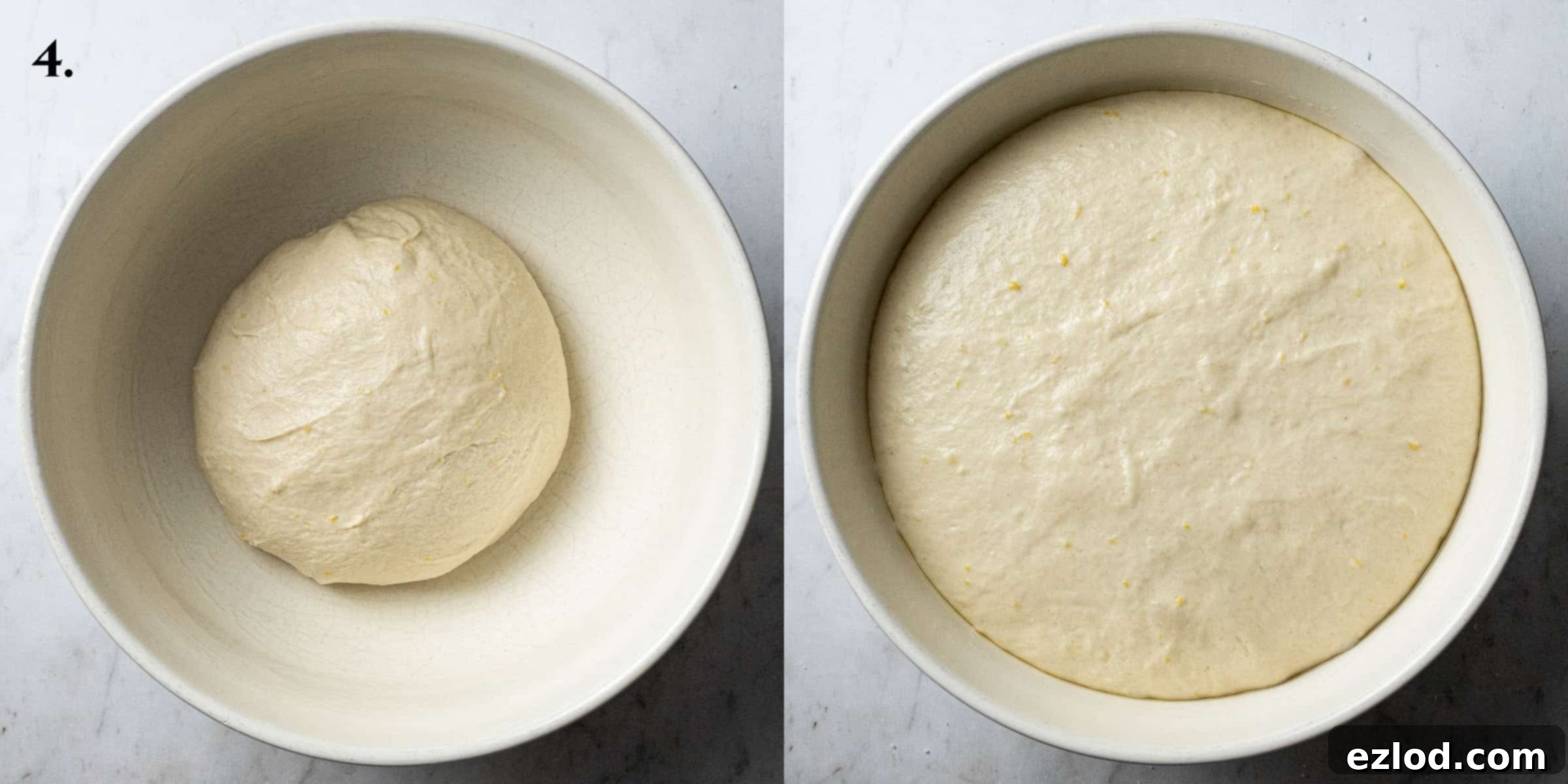
Step 5: Prepare the Aromatic Filling. While the dough is on its first rise, prepare the vibrant lemon coconut filling. In a small bowl, combine the caster or granulated sugar with the finely grated zest from the remaining three lemons. Use your fingertips to rub the lemon zest into the sugar. This action releases the essential oils from the zest, infusing the sugar with an intense lemony fragrance and flavor. Once thoroughly combined, stir in the unsweetened desiccated coconut until evenly mixed.
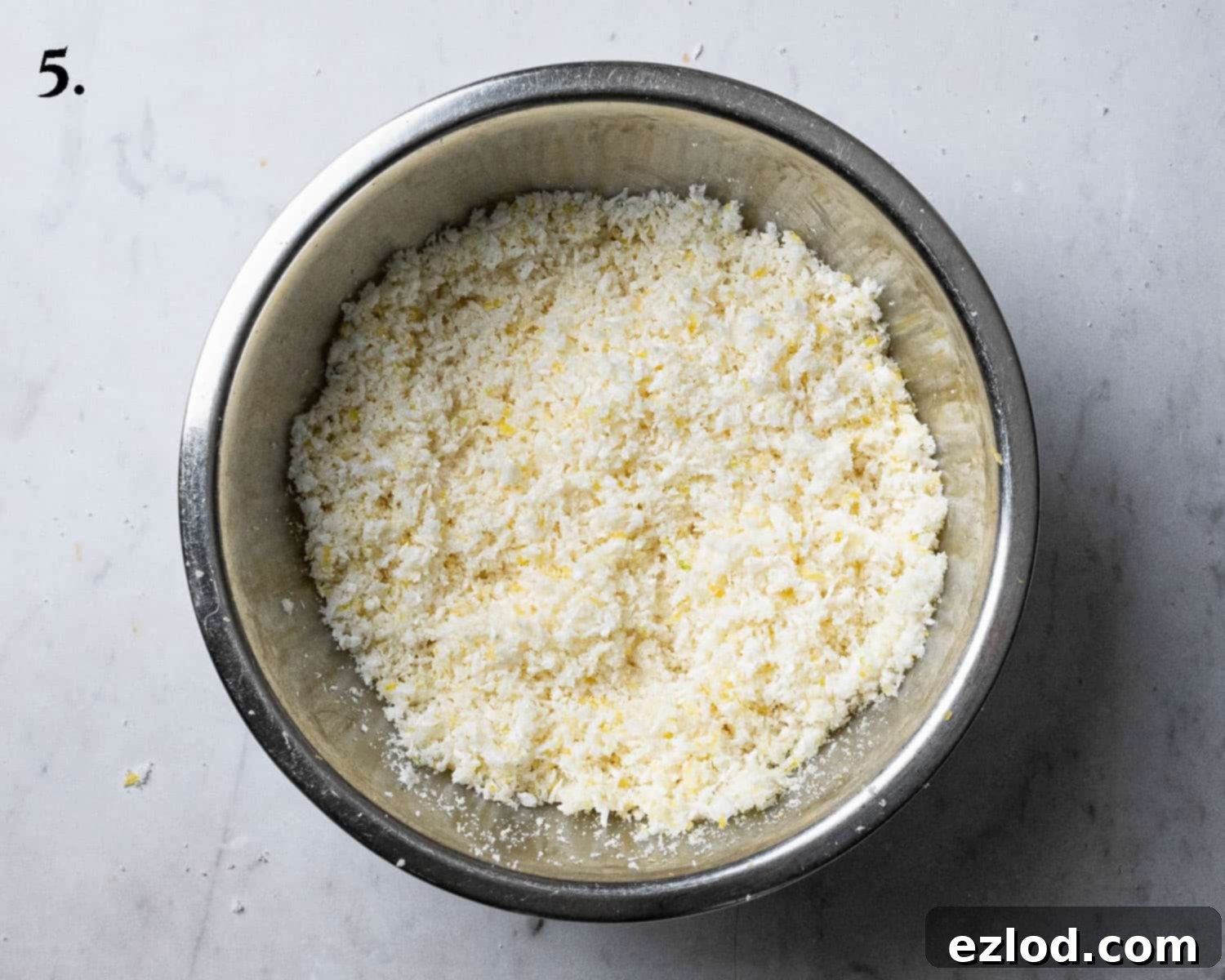
Step 6: Shape and Spread. Once the dough has doubled in size, gently punch it down to release the air. Turn it out onto a lightly floured work surface. Using a rolling pin, roll the dough into a large, even rectangle, approximately 30 x 45cm (12 x 18 inches). Ensure the thickness is consistent. Now, take the very soft vegan butter for the filling and use your hands or an offset spatula to spread it evenly over the entire surface of the rolled-out dough, reaching almost to the edges.
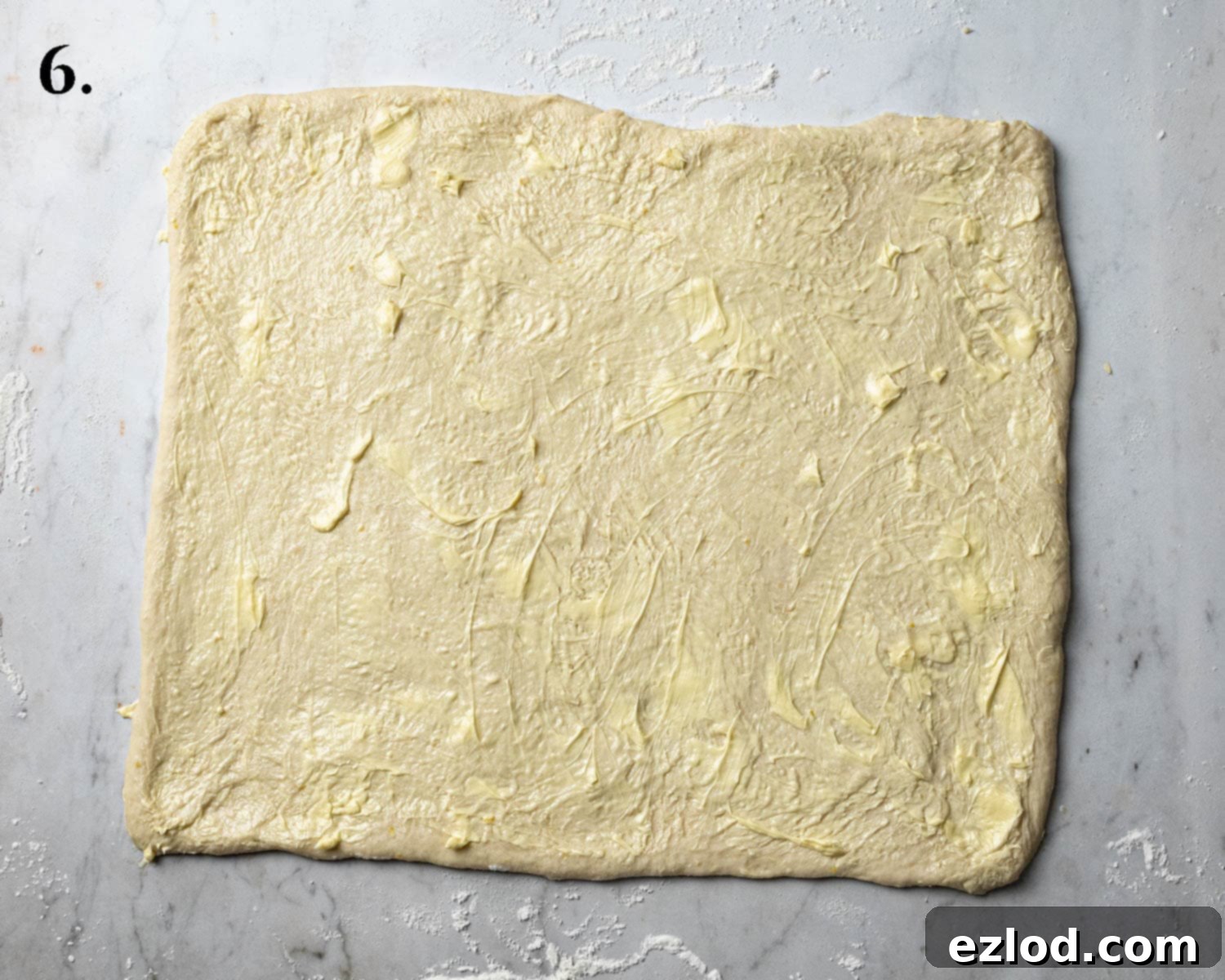
Step 7: Apply Filling and Slice. Generously sprinkle the prepared lemon coconut sugar mixture over the butter-coated dough. Gently pat it down with your hands to help it adhere to the butter. Using a pizza wheel or a very sharp knife, cut the dough widthways into 5 even strips. Then, cut lengthwise into 4 equal strips, creating a total of 20 squares of dough, each beautifully coated with the filling.
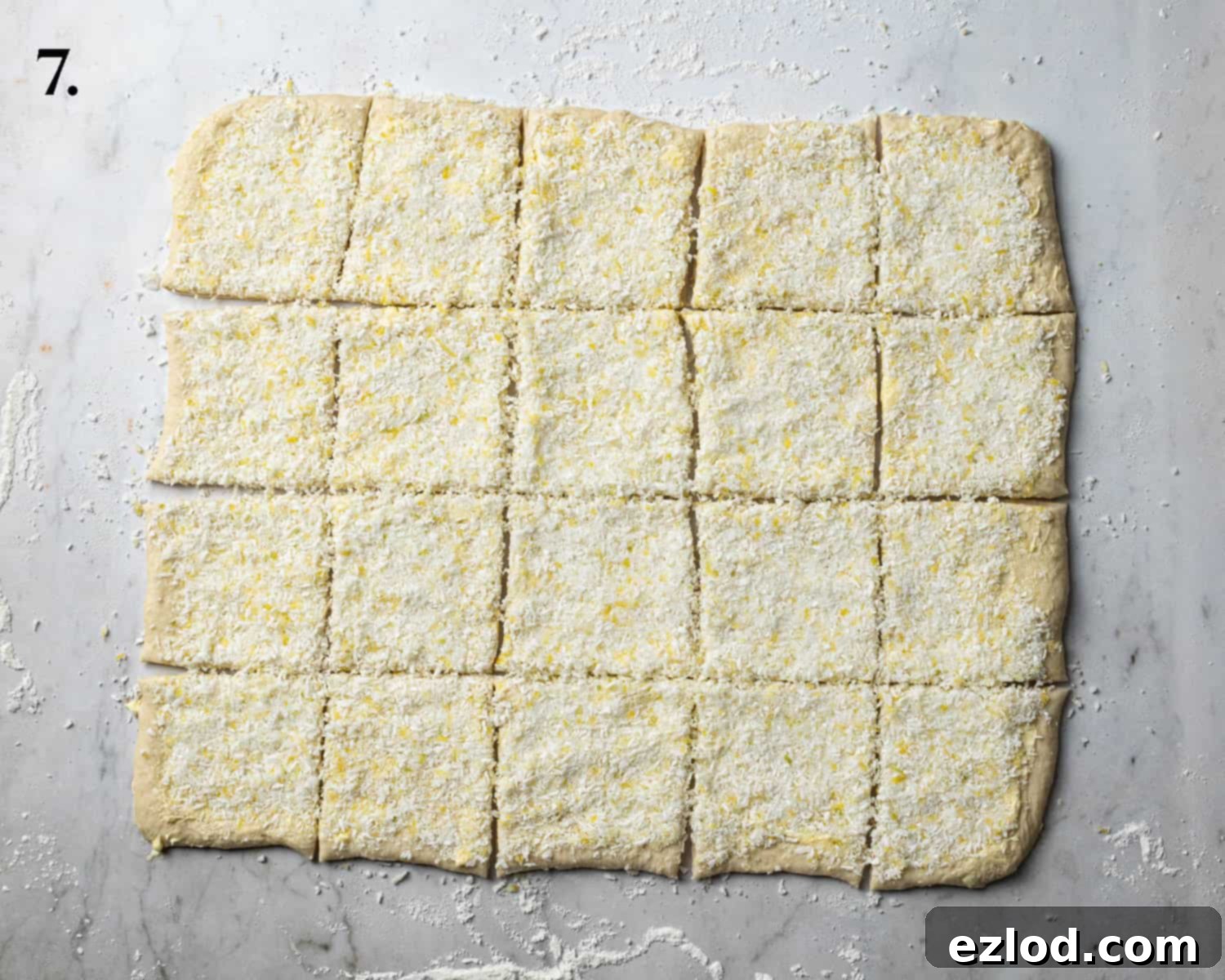
Step 8: Stack the Squares. Carefully stack the 20 individual dough squares into 5 neat piles, ensuring each pile contains exactly 4 squares. This is the key to the “pull-apart” effect, allowing each layer to bake into distinct, tearable pieces.
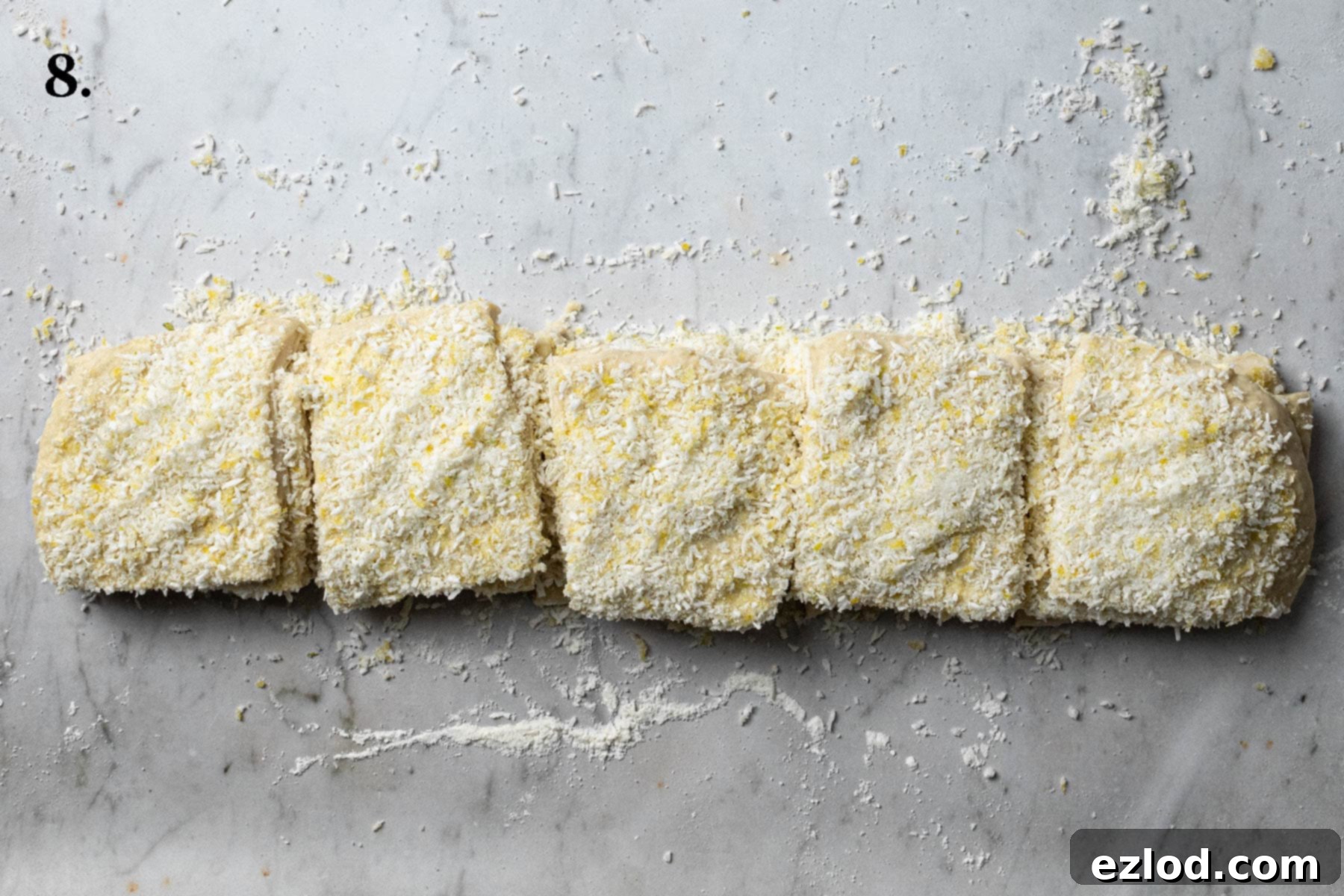
Step 9: Second Rise in the Pan. Line a 2lb loaf tin with greaseproof paper, ensuring some overhang to help with removal. Carefully arrange the stacks of dough squares upright in the prepared loaf tin. You may need to gently squash them together slightly to fit all five piles snugly into the tin. Don’t worry if some coconut filling falls off; simply gather it up and scatter it over the top of the stacked dough. Loosely cover the tin with plastic wrap or a damp towel and let it rise in a warm spot for about 45 minutes, or until the loaf looks noticeably puffy and has expanded.
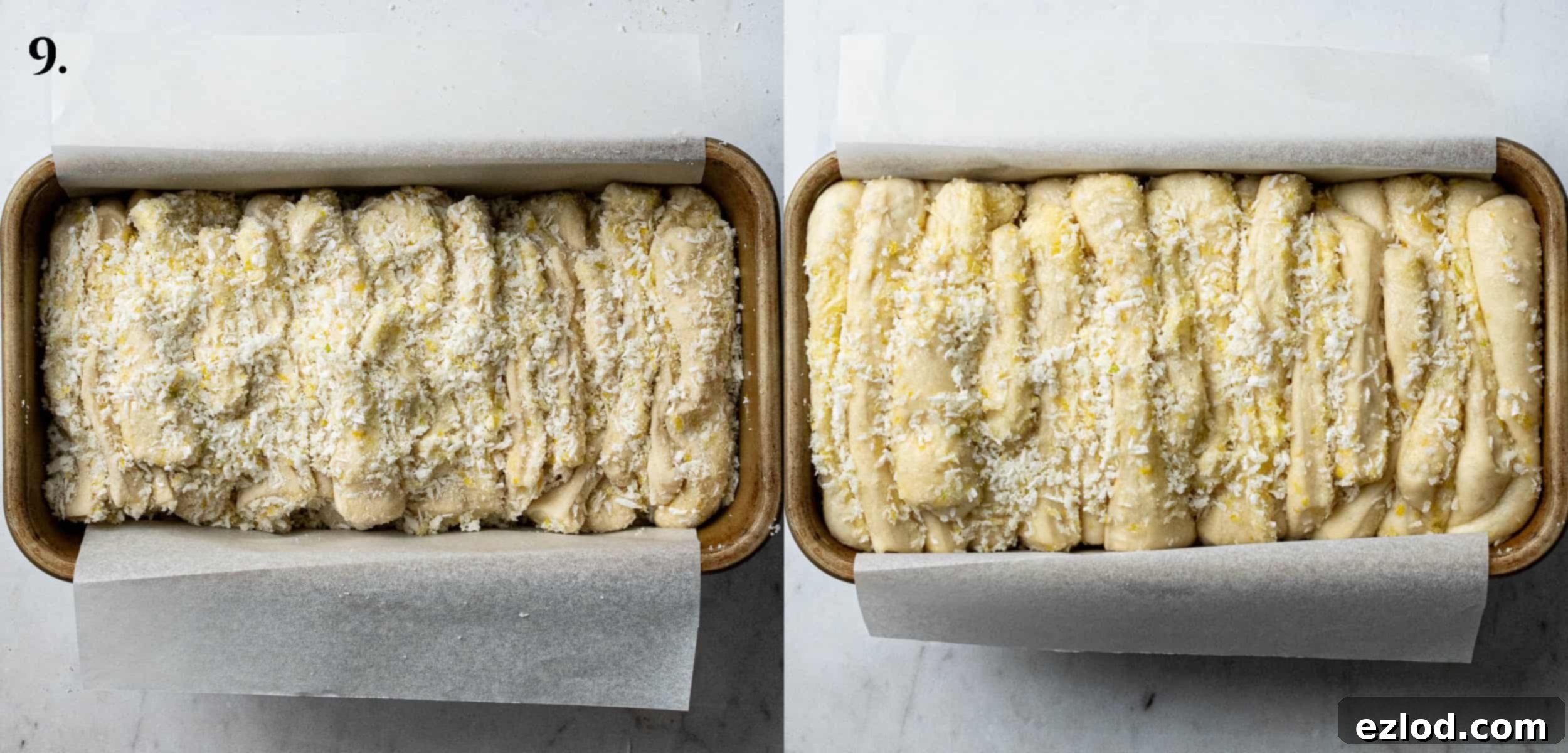
Step 10: Bake to Golden Perfection. While your dough is on its second rise, preheat your oven to 190°C/170℃ fan/375°F/gas mark 5. Once the loaf has risen beautifully, place the tin into the preheated oven and bake for approximately 45 minutes. The bread should be a gorgeous golden brown on top, well-risen, and fragrant. The best way to confirm doneness is to check the internal temperature, which should register at least 90°C/194°F with a probe thermometer, or a skewer inserted into the center should come out clean. Once baked, allow it to cool in the tin on a wire rack for about 10 minutes before removing it.

Step 11: Drizzle with Zesty Glaze. While the bread is cooling slightly, prepare the bright lemon glaze. Sift the icing (powdered) sugar into a small bowl to remove any lumps, ensuring a smooth finish. Stir in the coconut milk and 1-2 teaspoons of fresh lemon juice. Mix until you achieve a smooth, pourable consistency. If the glaze is too thick, add a tiny bit more lemon juice; if it’s too thin, whisk in a little more sifted icing sugar. Once the bread is out of the tin and on a serving dish, generously pour the glaze over the warm loaf, letting it cascade down the sides. Serve this incredible lemon coconut pull-apart bread warm and enjoy the pure delight of each sweet, sticky, and tangy piece!
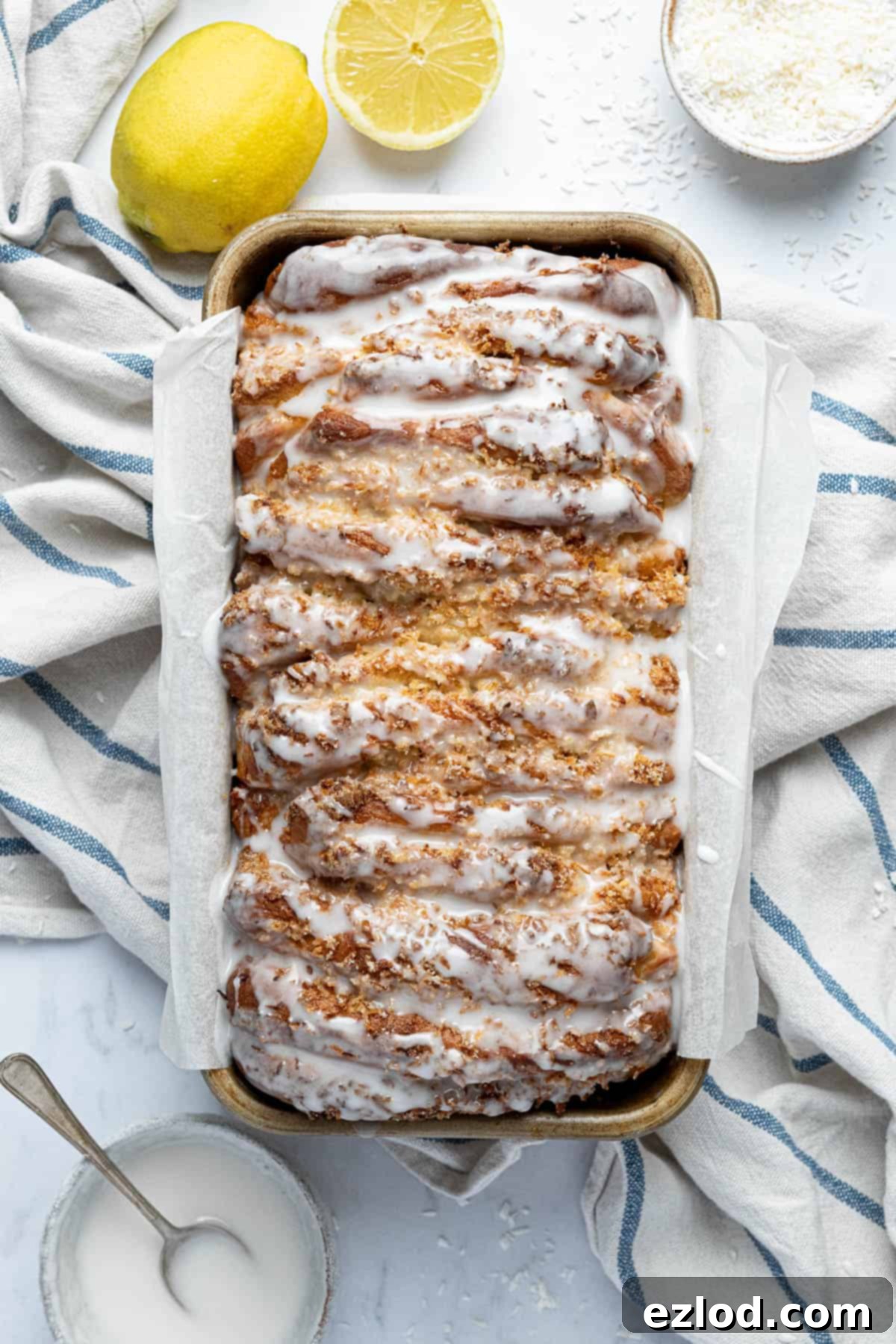
Expert Tips for the Best Vegan Lemon Coconut Pull-Apart Bread
Here are some invaluable tips to ensure your homemade lemon coconut pull-apart bread turns out perfectly every time:
Precision with Metric Measurements: As with all my baking recipes, I wholeheartedly recommend using metric measurements and a digital scale instead of cup conversions. Cups are notoriously inconsistent and inaccurate, leading to varying results. A digital scale ensures precise measurements, leading to much better, more consistent outcomes, and often a cleaner baking experience too!
Yeast Vitality: Always check the expiry date on your instant/fast action yeast. Old or inactive yeast is the most common reason for bread dough failing to rise. A quick way to test if your yeast is still good is to mix a small amount with warm water and a pinch of sugar; if it froths within 5-10 minutes, it’s active.
Understanding Rising Times: The time it takes for dough to rise (proof) is significantly influenced by the ambient temperature. On warmer days, your dough will rise much faster than on cooler ones. If your kitchen is cold, you can create a warm spot by turning on your oven to its lowest setting for a few minutes, then turning it off and placing the dough inside (with the door ajar) for a gentle, warm environment.
Overnight Rise for Enhanced Flavor: For an even deeper flavor profile and to break up the workload, consider giving the dough its first rise overnight in the refrigerator instead of at room temperature. The slow, cold fermentation develops more complex flavors. Just remember to allow the dough to come closer to room temperature before rolling it out and proceeding with the rest of the steps.
Serving and Storage Suggestions: While this lemon coconut pull-apart bread is truly at its absolute best when enjoyed fresh and warm from the oven, it remains delightfully soft and delicious the following day. For an optimal experience, I recommend warming it slightly in the microwave for 20-30 seconds or in a low oven for 5-10 minutes before serving on day two.
Flavor Variations: Don’t limit yourself to just lemon! For a different citrus twist, you can easily swap the lemon zest for finely grated orange zest or vibrant lime zest. Each will bring its unique aromatic quality to this versatile sweet bread, offering a fresh experience.
Frequently Asked Questions (FAQ’s) about Vegan Lemon Coconut Pull-Apart Bread
To maintain its freshness, store the lemon coconut pull-apart bread in an airtight container at room temperature. It will remain wonderfully soft and enjoyable for up to 2 days. Keeping it sealed prevents it from drying out and helps preserve its sticky, tender texture.
Absolutely, yes! The baked lemon coconut bread freezes beautifully once it has cooled completely to room temperature. For optimal freshness, it’s best to freeze it on the same day it is baked. Ensure it is stored in an airtight container or thoroughly wrapped in plastic wrap and then foil to protect it from freezer burn. When you’re ready to enjoy it, allow the bread to defrost fully at room temperature. You can then refresh it by warming it in a low oven (around 150°C/300°F) for about 10 minutes, or in the microwave for 20-30 seconds, until warm and soft again. I do not recommend freezing the unbaked dough, as the yeast activity can be unpredictable after thawing.
This dough is intentionally soft and a bit sticky, which is what contributes to the bread’s incredible tenderness. While a stand mixer with a dough hook will certainly make the kneading process much easier and less messy, you absolutely can knead it by hand if you don’t have one. Be prepared for a bit of a workout and to get your hands slightly sticky! When kneading by hand, avoid adding excessive flour to your work surface, as this can make the dough too dry and tough. Instead, if the dough becomes overly sticky, lightly oil your work surface and your hands to help manage it. A bench scraper is an invaluable tool for hand kneading; it helps you scrape the dough from the surface and fold it efficiently without having to use too much extra flour.
The most reliable method to determine if your lemon coconut pull-apart bread is fully baked is by checking its internal temperature with a probe thermometer. Insert the thermometer into the center of the loaf; it should register at least 90°C (194°F). If you don’t have a probe thermometer, look for visual cues: the bread should be beautifully risen and golden brown across the top. Additionally, you can perform the skewer test: insert a clean wooden skewer or toothpick into the center of the loaf; it should go in and out smoothly with minimal resistance and emerge completely clean, without any wet dough clinging to it.
Unfortunately, I’m afraid this recipe cannot be easily adapted for gluten-free flour. Baking truly good gluten-free bread is a complex art, and simply substituting gluten-free flour for wheat flour will not yield satisfactory results in this recipe. The entire formulation of the dough, including hydration levels and leavening, would need to be completely reworked to accommodate gluten-free flours. Gluten-free baking is not my area of expertise, and I cannot provide reliable advice on adapting this specific recipe. For successful gluten-free baking, it is always best to seek out and use a recipe that has been specifically designed and tested with gluten-free ingredients rather than attempting to modify a traditional wheat-based recipe.
More Delicious Vegan Sweet Bread Recipes to Explore:
- Vegan Banana Monkey Bread
- Jamaican Spice Bun
- Mocha Cinnamon Rolls
- Rhubarb Frangipane Buns
- Banana Bread Cinnamon Rolls
- Chocolate Chip Pumpkin Rolls
- Vegan Cinnamon Rolls
- Vegan Belgian Buns
- Vegan Chocolate Babka
- Vegan Pumpkin Pecan Babka
- Maple Pecan Bread Wreath
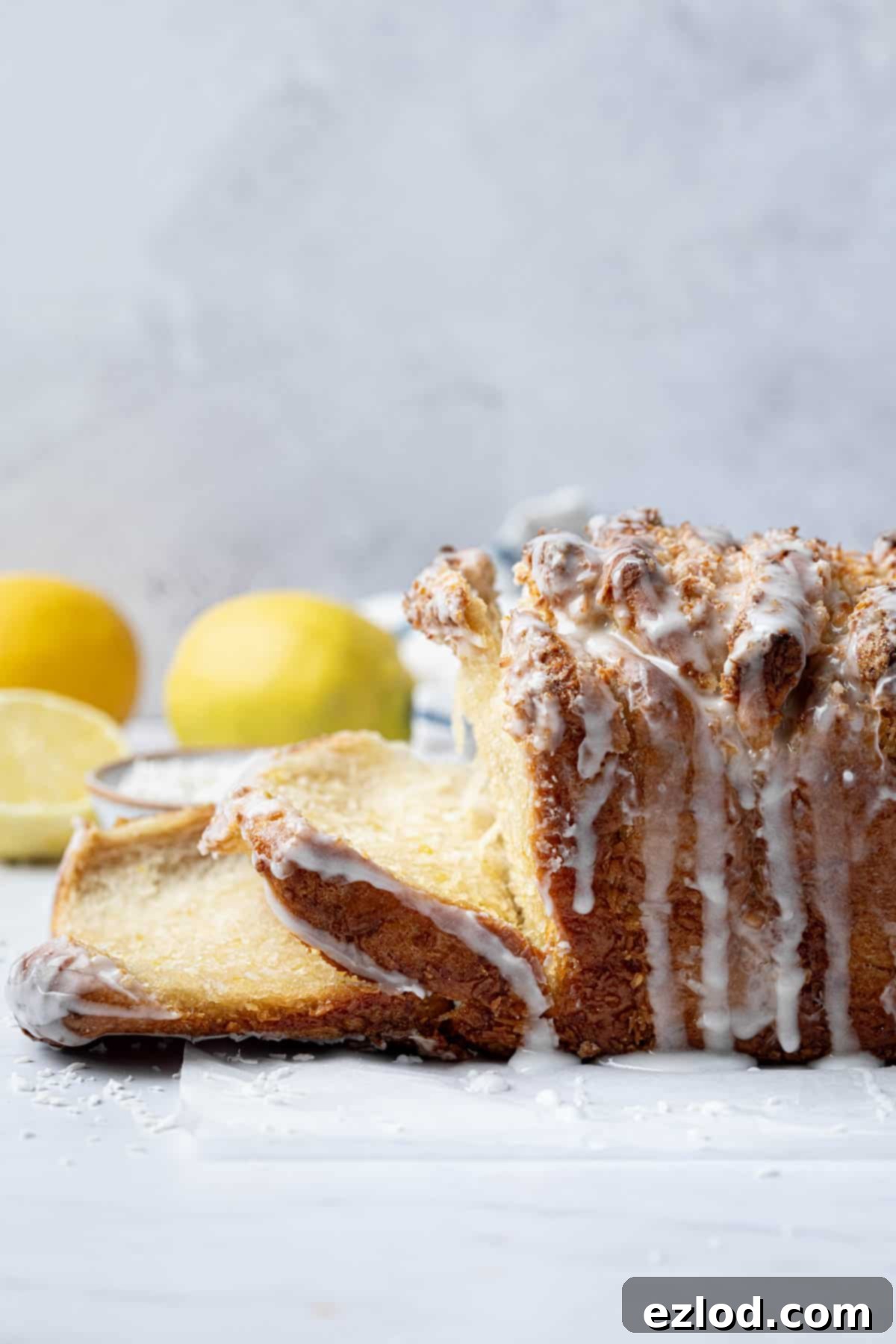
If you’ve tried this delightful vegan lemon coconut pull-apart bread recipe, I would love to hear how it turned out for you! Please take a moment to rate it, leave a comment below, or share your creation on Instagram by tagging @domestic_gothess and using the hashtag #domesticgothess. Your feedback and photos are greatly appreciated!
All images and content featured on Domestic Gothess are protected by copyright. If you wish to share this recipe, kindly do so by utilizing the provided share buttons. Please refrain from screenshotting or posting the full recipe or its content; instead, include a direct link to this post for the complete recipe. Thank you for respecting these guidelines.

Lemon Coconut Pull-Apart Bread (vegan)
Ingredients
Dough
- 400 g (3 + ⅓ cups) white bread flour
- 7 g (2 teaspoons) fast action yeast
- 40 g (3 Tablespoons) caster or granulated sugar
- 1 teaspoon salt
- 250 g ( 1 cup) full fat coconut milk
- finely grated zest of 1 lemon
- splash of water as needed
- 40 g (3 Tablespoons) vegan butter softened
Filling
- 125 g (⅔ cup) caster or granulated sugar
- finely grated zest of 3 lemons
- 60 g (packed ¼ cup) unsweetened desiccated coconut
- 40 g (3 Tablespoons) vegan butter very soft
Glaze
- 80 g (¾ cup) icing (powdered) sugar
- 1 Tablespoon coconut milk
- 1-2 teaspoons lemon juice
Instructions
-
Place the flour in a large bowl, add the yeast to one side and the sugar and salt to the other. Add the coconut milk and lemon zest and stir to form a dough, adding a splash of water as needed until all of the flour has been picked up.
-
Turn out on to an un-floured surface and knead for about 10 minutes until smooth and elastic (use a stand mixer if you have one), the dough should be sticky at first but will become smooth after a few minutes of kneading.
-
Add the softened butter and knead until it is fully combined and the dough is smooth and stretchy. It should still have a fairly soft, sticky texture, resist the urge to add more flour.
-
Transfer the dough to a lightly greased bowl, cover and place in a warm spot for an hour or so until doubled in size.
-
Line a 2 lb loaf tin with greaseproof paper. For the filling, place the sugar and lemon zest in a bowl, use your fingertips to rub them together to release the oils from the lemon, then stir in the desiccated coconut.
-
Roll the dough out on a lightly floured surface into an approx 30 x 45cm (12 x 18 in) rectangle. Use your hands to spread the butter evenly over the dough. Scatter over the coconut sugar mixture and press it down gently.
-
Slice the dough widthways into 5 even strips (a pizza cutter is the ideal tool), then lengthwise into 4 strips, to make 20 squares of dough. Stack the squares into 5 piles, each with 4 squares.
-
Stack the dough piles upright in the tin, squashing them together to fit them all in. Gather up any coconut filling that fell off and scatter it over the top. Loosely cover the tin, and leave to rise in a warm place for about 45 minutes until puffy.
-
Meanwhile, preheat the oven to 190°C/170℃ fan/375°F/gas mark 5.
-
Bake for about 45 minutes until the temperature in the centre registers at least 90°C/194°F on a probe thermometer, or a skewer inserted into the centre comes out clean.
-
Allow to cool for 10 minutes in the tin on a wire rack.
-
Meanwhile, make the glaze; sift the icing sugar into a small bowl and stir in the coconut milk and lemon juice. It should be a pourable consistency, add a little more lemon juice if it is too thick or a little more icing sugar if it is too thin.
-
Turn the bread out onto a serving dish and pour over the glaze. Serve warm.
Notes
- See post above for additional tips, detailed explanations, and step-by-step photos that will guide you through the process. Many common questions about the recipe are likely answered within the main article!
- For consistent and superior baking results, I highly recommend using metric measurements and a digital kitchen scale for all ingredients, rather than relying on volume-based cup conversions. Digital scales provide much greater accuracy, which is essential for successful baking and often results in less mess.
